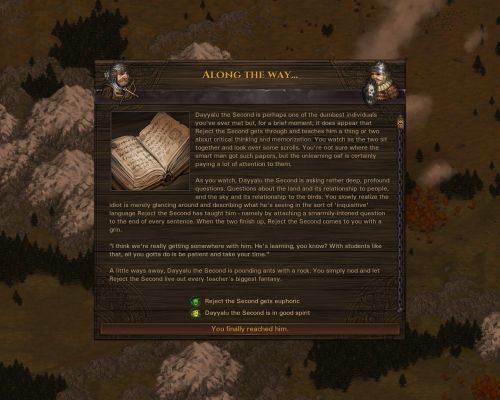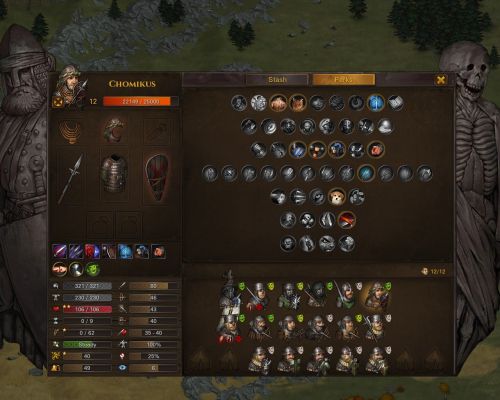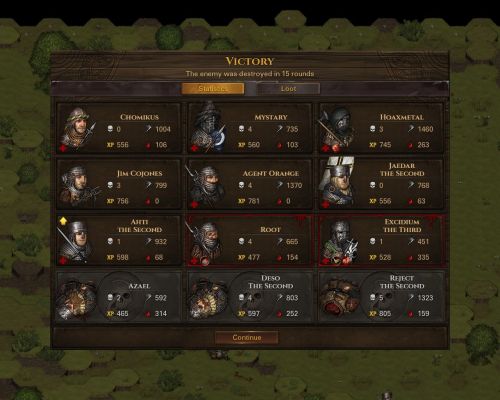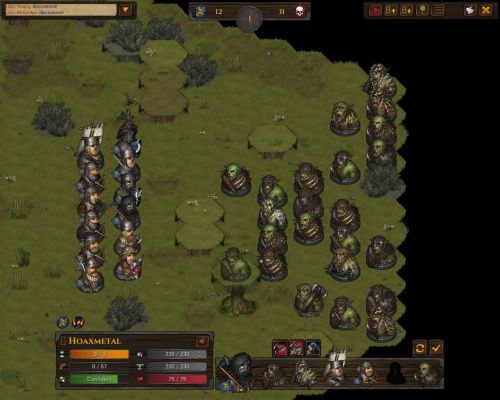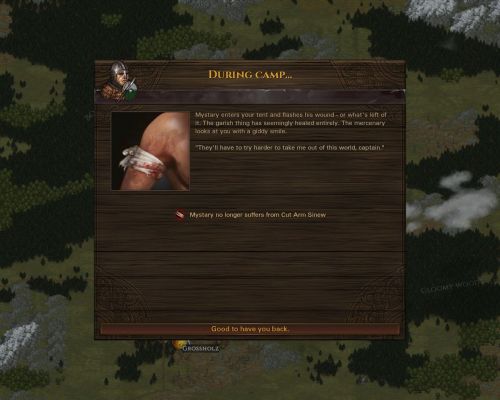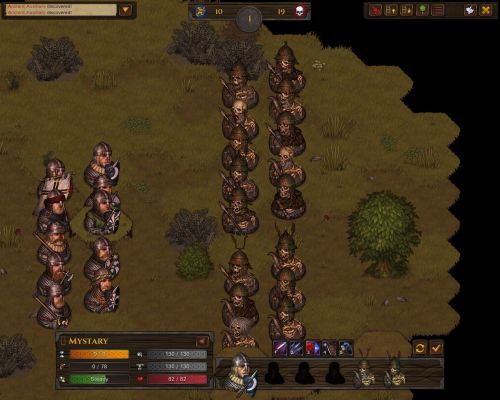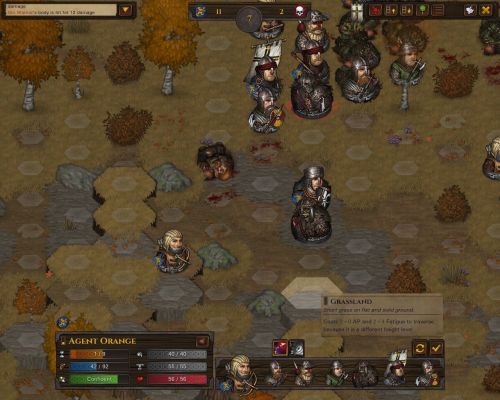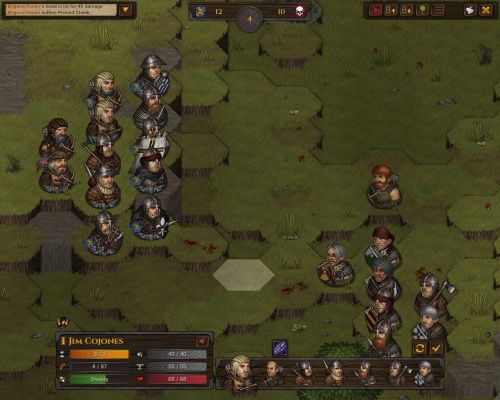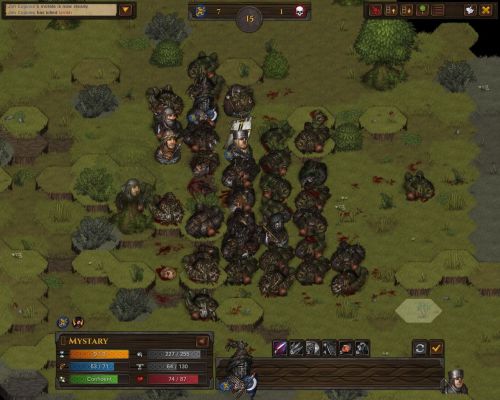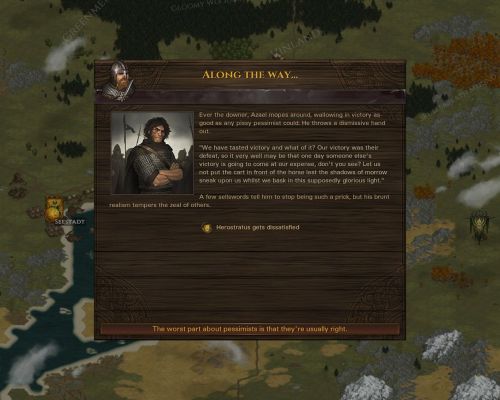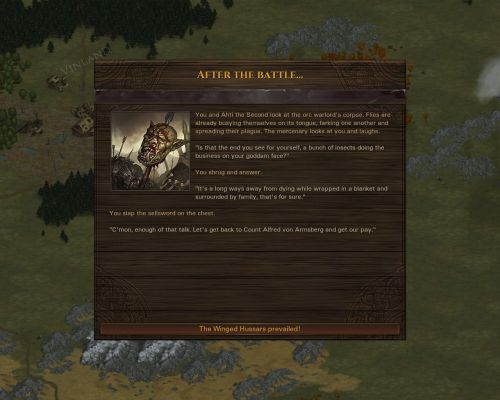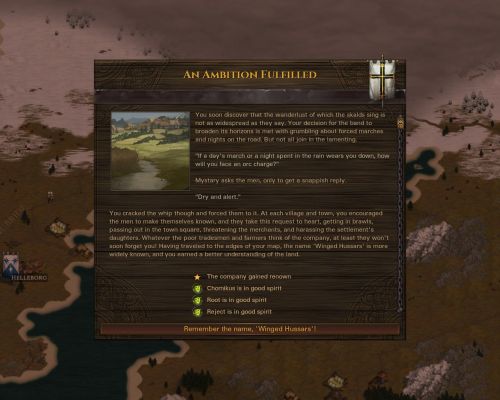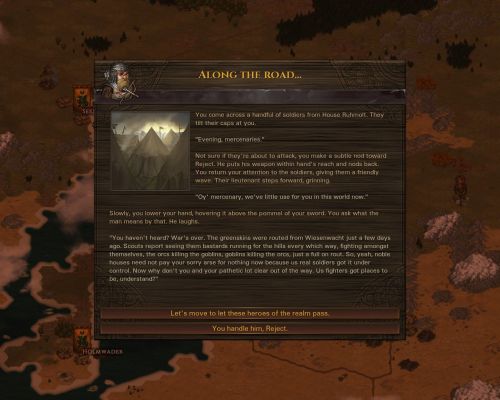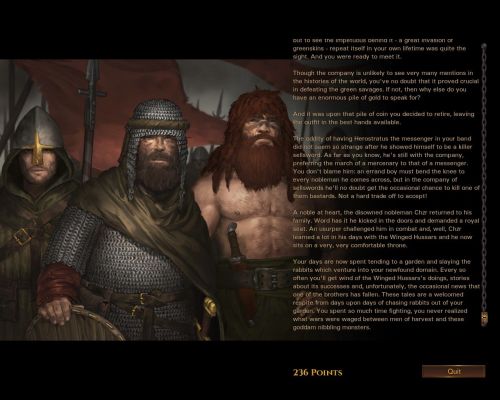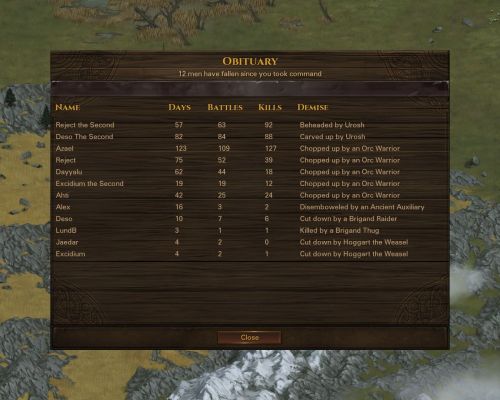RPG Codex Review: Battle Brothers
RPG Codex Review: Battle Brothers
Codex Review - posted by Infinitron on Fri 12 May 2017, 23:44:15
Tags: Battle Brothers; Overhype Studios[Review by Darth Roxor]
Battle Brothers is a turn-based tactics game by the debuting Overhype Studios, a small team of developers from Germany. Since its announcement and later release on Steam Early Access (April, 2015), it’s apparently been winning the hearts of RPG Codex users worldwide through its focus on unforgiving combat, tacticool opportunities, yadda yadda, the usual. Some have even proclaimed it the best X-COM-like game in a very long time.
I say “apparently” because the Battle Brothers modest “hype” phase more or less flew over my head, so I’m drawing these conclusions from scraps of memory and hearsay. Still, by the time of its proper release (March, 2017), so many people had recommended it to me, that I figured I might as well get it blind, especially because I do like me some tacticool turn-based murder simulators, so I had little worry that I’d be disappointed.
Also, as a general disclaimer, we all know the horror posed by the question “what is an RPG?”, especially when it comes to borderline cases like Battle Brothers et al. My personal Roxorowski’s Razor for this problem is comparing the game in question to Jagged Alliance 2 – if it has as many, or more, “RPG” elements as JA2, then it’s an RPG. If not, it’s not. In my view, BB lacks a lot to be an RPG, so I’ll be mostly comparing it to more direct competition the likes of Xenonauts, Mordheim, etc.
Today the enemy is at our door
The game launches you straight into action. Start the campaign and you’ll find yourself in the middle of a fight gone terribly wrong between your mercenary company and the infamous bandit Hoggart the Weasel. Half your band, including the captain, bite the dust, and the remaining battle brothers agree to nominate you as the new leader. This is everything you’ll ever get in terms of an introduction or tutorial – after that, the game throws you out into the deep waters and tells you to learn how to swim.
Once the intro battle is done, you land on the world map. This is where you move your band around, take quests, manage your characters, etc. The map is randomly generated and includes a number of villages and cities, a road network, gazillions of random encounters and enemy lairs, and various landscapes, such as plains, mountains, swamps, forests and deserts. It is also fully open from the get-go, with only one barrier that stops you from going wherever you want – your supplies.
Each day they are on the road, your mercenaries are going to need at least food and money to keep them going. Otherwise, they will quickly renounce your leadership and start deserting. Three additional types of supplies are also necessary to keep them in fighting condition – tools to repair their equipment, healing supplies to heal their wounds and ammunition for their ranged weapons. These five supplies are all there is to any kind of “macromanagement” in Battle Brothers – as long as you keep these counters up, your folks will be okay. You will soon notice that supplying the company is a non-issue since towns sell supplies to your heart’s content and let you stock up on generous reserves should you wish to go on a longer escapade outside the bounds of civilisation. So, in essence, the only resource that really matters is gold, as the other supplies translate into it directly anyway.
But obviously, what really makes a warband is its members, so let’s talk about those. You can hire up to 20 mercenaries, but only 12 are admitted at maximum into battle – the rest will have to be placed in the reserves. Each fighter is characterised by a randomly generated set of variables. These are general statistics (such as health, stamina, initiative, etc), talent stars (how good a brother is at a particular skill, and how well he will advance in it as he gains experience), background and traits (both positive and negative, such as a stamina bonus or cowardice).
The character system is basic, but it allows for some fun mixing and matching of dudes, especially thanks to the multitude of backgrounds, which will no doubt make every fan of Warhammer Fantasy smile – it’s all there: rat catchers, beggars, cripples, grave robbers, deserters and killers on the run, but also hedge knights, witch hunters, militiamen, monks and swordmasters, and many more. The backgrounds give you a rough approximation of what the merc will be good at – grave robbers have higher resolve, cripples are ailin’, swordmasters have high melee, etc. Every now and again, certain characters will also provide you with short text events that give them some life, such as a nobleman and a peasant brawling over their privileges.
However, this mixing and matching is severely hampered by one design decision that I cannot understand. All character variables, except background, are invisible to the player before a fighter is hired, making recruitment feel like a lottery. For example, that hedge knight that you’ve just bought for a whopping 4k gold might turn out to be a half-blind clumsy coward with a schizophrenic spread of stats and talents, while the 150 gold beggar might be a marksman in disguise. It is absurd and frustrating for plenty of reasons. First, believability – if you’re supposed to be the “HR manager” of this company and you can’t spot that the guy you want to hire is as dumb as a sack of bricks, then you aren’t very good at your job. Second, you might end up scouring the entire map to get a replacement for a particular character and find none. I once had to look for a new archer – I hired 6 different ranged specialists all around the world, and none of them had ranged combat talents. Third, the whole “cat in the bag” aspect. It makes sense to randomise rookie stats in a game like X-COM, where all recruits cost the same and can be expected to have similar stat ranges. But in BB, where the hiring cost can range from 100 to 6000, where the recruits have different stat ranges based on background, and where they can also start with their own gear, an additional level or two of experience and crippling negative traits, hiding their stats from you is nonsensical.
Still, there’s more to a hero than just the starting stats. There’s also experience and equipment.
Mercs get experience by fighting and living to tell the tale. Once enough XP is accumulated, a character advances a level and gets bonus stat points and a perk. Bonus points per level are available for all stats, but you can pick only 3, and their values are random, albeit influenced by the character’s talent stars. Perks are special abilities that are arranged in a tiered “tree”, where new tiers are unlocked at every level up.
Now, the perks are a bit tricky. Their functionalities vary greatly, from new active abilities to passive stat bonuses, and so does their usefulness. As you play, you will soon start noticing that some of the perks are very devious trap options, while others are must-haves to even make some combinations viable. This isn’t necessarily bad, but what’s much worse is that once you pick the few “must-haves”, you’ll notice you've run out of perks to take and are just comparing what’s left in terms of which is the least useless. It was especially true for me with regard to archers – past a certain point, I could just as well choose perks by closing my eyes and pointing at something random.
A major consequence of the above is that the relative usefulness of the perks leads to homogenising your crew within specific archetypes and invalidating the initial fun you’ve had with mixing and matching. In my experience, there are 5 archetypes: shield guys, archers, two-handers, one-handed duellists and standard-bearers. Of these, you won’t be able to have more than 1 standard-bearer, so it can be disregarded. Then you have shield guys, duellists and archers, whose level-up “paths” make them end up as near-100% clones of each other. Only the two-handers really give you some room to experiment, which is mostly thanks to the weapon diversity available to them.
So, let’s talk gear. Weapons in BB are surprisingly well-rounded, with each weapon class having its own niche, although many of these have situational uses that you wouldn’t want to employ for every fight. Examples include flails that ignore shields, pikes with extended reach or hammers that do extra damage to armour. What further differentiates between weapon classes are their special moves – the flail can also be aimed for the head (extra useful against gits without helmets), the pike can poke an enemy back one hex and the hammer can do an even more armour-wrecking attack. With some 12 weapon classes in total (9 melee, 3 ranged), there is a lot to choose from. But there is still room for improvement: what bothers me about the weapon selection is that one-handed weapons all follow a linear, “tiered” progression. A hatchet, a handaxe and a fighting axe differ only in statistics, which rise proportionally for each “tier”. The same is true for ranged weapons. Two-handers, on the other hand, offer lots of variety in functionality – a pike can poke an enemy back, while a billhook can drag him towards you. A longaxe has two-hex reach, while a greataxe can do a multi-target sweeping attack. And so on.
Armour choice is not as involved as the weapons, however. Taking inspiration from such tactical classics as Doom, armour works as additional HP shielding your characters from a premature death. The heavier the armour, the more protection it offers, but the more it hampers your maximum fatigue (more on this later), so typically you want to find a sweet spot between dressing yourself with toilet paper and becoming a living roadblock.
Apart from arms and armour, there are also auxiliary items, and though they aren’t particularly numerous, they can be interesting – for example, you can buy attack dogs from kennels and unleash them in battle to get a fast-moving, uncontrollable ally. Or throw nets around to hold enemies in place.
When you pour all the character development info together and look at it closely, you might draw one conclusion. Battle Brothers is a bit confused when it comes to squaddies. On the one hand, they’re supposed to have high mortality and be easily replaceable, which is why most of the elements are kept simple and why you can’t view their stats during recruitment. But on the other hand, some of them cost a small fortune, and losing a high-level merc with expensive armour can be a gigantic setback, both in terms of cash and overall warband combat efficiency.
It’s made even worse by how barebones everything is here, which stems from the lack of any R&D or real unit upgrades, because the tiered arms and armour or the lacklustre perks don’t really cut it. Compare, for example, to X-COM and Mordheim. In X-COM, it’s mostly the gear that matters, while dudes are expendable – and the extended R&D continues to unlock new options for you that stay useful even in case of a total party wipe (blaster launchers, jetpacks, psi, etc). In Mordheim, what is lacking in gear is offset by ability unlocks that can take characters along a multitude of playstyles, and the importance of characters over gear is further offset by giving them much greater survivability than in X-COM & friends.
Meanwhile Battle Brothers… Characters are flimsy, but expensive. They have unlockable abilities, but almost none that would be “gamechanging” for them. They are mostly defined by their gear, but the gear stops opening new options quickly, opting instead to just increase numbers. So in the end you’re left with a warband of 12 piggy banks – they all look kind of the same, they break easily and they keep hogging all your gold. It is a great shame because, like I said before, the initial warband building aspect, where you transform beggars and thieves into semi-competent fighters, is very enjoyable. It’s just that the advancement scale is very disproportional, and as you proceed through the game, you will notice that your room for improvement is consequently narrowing, while your mercenaries stop “changing”, but at the same time become more expensive and costly to replace, both in terms of money and time spent on getting your company back into shape.
We die heroes’ deaths
All that talk about dudes that do the fighting, but still no mention of the actual fighting. Let’s rectify that. There is no doubt that the developers of Battle Brothers have focused the majority of their effort on the basic combat engine – it is by far the most thought-through element of the game.
Once a battle is initiated, your band lands on a hex-grid map, in a two-row formation that you’ve set up earlier in the band management screen. The enemy mob is a few paces away and also set up in rows. Then the two start exchanging blows in turn-based combat until one side is wiped out or forced to retreat.
All combatants are characterised by a number of vital statistics that govern the flow of the fight. Apart from the self-explanatory action points, HP or melee/ranged skills and defences, there are a few others that need mentioning to explain how the otherwise simple stat selection ties into the overall combat system. Those are fatigue, initiative, resolve and morale.
Everything you do, from movement to advanced combat manoeuvres, costs fatigue to use. If you spam abilities without thinking, your merc will soon find himself unable to do even the most basic things and end up as a sitting duck. Fatigue management in BB is hell, though, because there’s only one real way to regain it – skipping your turn – while there are a multitude of ways to lose it, particularly by getting hit or limiting your fatigue cap with equipment.
Initiative obviously governs the turn queue in combat, but there is one important aspect to it – it is also influenced by fatigue. The more winded a character, the later he’ll act. However, it also makes the initiative queue in BB very unpredictable – you may never know when a character will act on the next turn, no matter what you do. A merc may go first on one turn and then be dropped to the end of the queue at the start of the next.
The fatigue and initiative coupling in the game is clever in theory, but I dislike its implementation heavily from a tactical perspective because it makes planning ahead more unreliable than it should be. You can figure out a clever tactic spanning a few characters for your next turn, and then have it fall apart from the onset because it turns out one of them dropped in the initiative queue by a few places after doing as much as attacking. And the worst thing is that it all snowballs – you can expect multiple mercs to take damage during a turn, and from that damage they get fatigue and lose initiative, which not only results in them being unable to use that one ability you really needed at the time, but also taking their turn at a moment you can’t possibly foresee. The consequences of all this are many, and you will hardly ever have much possibility to adapt to them.
Resolve and morale are also linked, but in a more simple manner. Morale is the gauge of your character’s confidence in combat, while resolve governs how likely this morale is to deteriorate if things go south. Take too much damage, see too many comrades die, and your merc will turn tail, becoming uncontrollable as he runs towards the edge of the map (or, more likely, gets butchered by attacks of opportunity along the way).
Health also deserves a mention here because a character loses more than just HP when he gets hit. Each sustained attack has a chance of inflicting a temporary wound, and the effects of these vary greatly, from near-insignificant to stat penalties across the board. Further, the wounds persist for a number of days and have to be treated using healing supplies. Also, if HP drops to zero, a character doesn’t have to die – on a rare occasion they get to roll vs death and survive with a permanent wound instead. However, many of these are so catastrophic that in practice you’re better off sacking the guy anyway.
Still, given that most enemies are also tied by the same rules, the basic system ensures that some fights can be pretty hectic and fun. Whether you straight up kill your enemies, tire them out or make them run, there are always plenty of twists and turns along the way that can make for some satisfying battles and outcomes.
However, the further we diverge from the basic system, the more chinks start appearing.
For instance, some of the enemies ignore a part of the above rules, and fighting them I can only describe as anti-fun. For example, BB’s skeleton legionaries have to be some of the most cancerous enemy type I’ve witnessed in years. Piercing damage is useless against them, they don’t have morale or fatigue, they trigger morale checks with every hit and they can’t take wounds. Meanwhile, the only thing they can do is advance as a blob with shields up, blocking most of your blows and laughing in your face as they shank you to death and send all your pansies running.
Another thing that is just about as cancerous are the line of sight rules for ranged combat. Basically, a shooter will have a clear line of fire only when there’s a 100% straight line of hexes between him and the target. Should the line of fire even do as much as brush another character next to the target, then it’ll count as obstructed, and you’ll most likely be shooting your own men in the backs – unless you’re firing from a hex directly behind the “obstruction”; then it’s all dandy for some ungodly reason. I think it took me 15 hours to get somewhat used to the idiocy that are the line of fire mechanics in this game, and even after that it would still manage to surprise me from time to time, like when a flat rock would prevent my archer standing on an elevated surface from shooting past it.
But those are just details compared to the biggest combat flaw in Battle Brothers that, to me, nearly invalidates the entire game’s purpose – the non-existent level design.
The combat maps in BB are generic tiled surfaces. They are flat as a pancake, with only some “elevated” hexes that just give you stat bonuses from height advantage or make running around slightly more inconvenient. They almost always start with the same “your dudes on the left, their dudes on the right” setup. There is nothing to actually do on them, because any sort of extended manoeuvring is pointless, except on mountain maps where you run to the nearest hill and bunker up, swamps where you have to run out of penalty-inducing water tiles should you start in them, or forests, which arguably is the only tile set with any room for some movement due to all the trees and shrubs that form natural chokepoints (and bring you even more “fun” moments with line of fire).
Worse yet, this lack of level design directly diminishes the value of BB’s otherwise robust bestiary. While the enemy types are fairly numerous, they get predictable very fast, to the point that you need just one or two fights against a “new” enemy to know everything he has to offer – this is particularly sad because many of the foes actually have various tricks up their sleeve and really clever AI scripts that will take you completely by surprise during your first encounter, like a necromancer who will always keep a “bodyguard” zombie next to him to obstruct the firing lines of your archers. But after that, it becomes routine, because the setup is always the same, and you can never expect something new to happen. Compare it, for example, to X-COM. Four sectoids with plasma rifles don’t appear like much. But depending on whether they landed or crash landed, in a medium or large scout, on a farmstead, in shopping mall or a jungle, your hunt against them will vary greatly. There is hardly anything of the sort to find in BB.
I can’t stress it enough how fatal are the two aspects above when it comes to any “staying power” Battle Brothers could have. A large, a huge part of all games like this is working with and against the environment. Setting up ambushes, moving carefully around corners, navigating through rooftops, tearing down walls that stand in your way, all of that is incredibly important to add a layer of emergent gameplay and replayability that is vital for everything. Without this emergent gameplay and the sense of unpredictability rising from enemies hiding somewhere in the fog of war, Battle Brothers gets old very soon. Same maps, same fights, same enemies, all the time until the bitter end is the name of the game here. As the game goes on and breaches a certain point where the strongest enemies start appearing, it’s over. The only new thing you’re ever going to see are increased numbers, with enemy mobs going from 6 to 12 to 20 and finally to 40. It’s nothing but tiresome.
The way all this ends up so samey and tiresome is a slap in the player’s face when you consider what this game is supposed to be about. Remember that your mercs are flimsy but important and expensive. Remember the unpredictability of planning. Remember that the lack of any real design supporting the combat engine essentially makes your entire campaign an extended fight against the random number generator. If something goes wrong, you can be sure it’ll snowball into a disaster.
And then you get a loading screen hint that says “losing is fun”.
Is it?
No, not particularly. Losing can be fun when you get something out of it (like having to evac after losing 10 squaddies, but at least managing to snatch a valuable alien artefact) or when you know you’ve really gone down after giving the enemy hell and exhausting all your options in an epic last stand, holed up in some garden house while rockets were flying all around. In BB losing means you were facerolled and now have to start building your band from scratch.
In fact, I would say not even winning is particularly fun in this game. One time I ended up fighting a gargantuan mob of 31 orcs led by a warlord. I won, but lost 3 veteran mercenaries in the process, plus two with permanent injuries. My reward? Some gold and a sack of junk to sell that barely even covered the monetary setback incurred by my losses, and nothing to offset the loss in experience, abilities and statistics from the dead vets. Each fight in Battle Brothers that you don’t finish with a flawless victory is a wake-up call that it’s time to get back to the grind.
Prepared to deep strike
There is one final aspect to Battle Brothers that needs discussing, i.e. what actually happens between fights.
The game has no real “goal” – you just take your warband from city to city, looking for work. Unfortunately, you will soon find that here the game does not diverge much from its combat problems. That is to say, it gets old very, very soon.
There are, let’s say, three main “objectives” for you to pursue. Contracts for cities, warband ambitions and a “late game crisis”.
For contracts, there is very little to do apart from “go there and kill stuff”. In essence, they are just glorified monster hunts that you get paid for, so there’s not really much to say about them. Just as everything else in this game, the contracts are in desperate need of variety. There is only one type that can be a bit more exciting, but it also tends to be very risky – caravan escort jobs. Upon accepting such a contract, you are tied to a caravan going to another city and have to fight everything that tries to attack it, with no time for R&R. Needless to say, if you face multiple encounters on the road, you’ll be in for a bad time.
Sometimes the contracts, or just walking around the map, will also involve going through short text interactions, but these are much too basic to be called any sort of “CYOA” sections or the like. With no skillchecks involved, they are mostly as simple as “Stuff happens. Do you do X or Y?” and then they end.
For some strange reason, your band is also banned from taking more than 1 contract at a time. No matter whether you’d want to take jobs involving two different cities, objectives, noble families. It’s 1 and only 1 at a time.
Ambitions are a bit more varied, but these are more like expanded in-game achievements. Still, at least they give you some objectives other than “go kill stuff” and sometimes conclude with unique rewards. For example, an ambition to get a company standard requires you to gather 2k gold, after which you obtain said standard and a sergeant’s sash, both of which are items that let you specialise characters into morale boosting banner bearers.
And then we have the late game crises…
There are three crises available – orc invasion, undead scourge and noble feud. You can either pick one or have it drawn randomly. I highly advise picking, so that you don’t end up with undead scourge and hang yourself due to the constant skeleton fights, but I digress.
As you play, you will start getting hints about a “looming” threat of some kind. This will be your cue that the crisis is coming. Once it triggers, the map will be flooded by enemies of a certain type. They will organise into war parties and prowl the land, destroying everything in their wake, even burning cities to the ground. Since local forces are completely useless, the fate of the free world lies in the hands of your company.
How do you stop a crisis? The answer is simple. Maim, kill, burn. MAIM, KILL, BURN!
The crises might as well be renamed into late game grindfests because that’s exactly what they are. You just run around slaughtering things en masse and try to match some hidden invasion meter that says how many more enemies you have to clobber for it to end. The sole indication of how you’re doing is a vague prompt that you’re “winning” or “losing”, which is activated only once you’ve taken an ambition to stop the invasion. The crisis unlocks a few new contracts, but nothing that would reach above “go kill stuff”, and nothing that would count as an “objective” of any sort. You are only expected to go forth and destroy.
After you’ve massacred enough enemies and met the hidden death toll quota, the crisis suddenly ends. Poof, just like that. Suffice to say, it feels about as rewarding as receiving an employee of the month diploma for your work at the corp.
There is no time to be lost
Obligatory tech chapter before proceeding to the conclusion.
The visual layer of Battle Brothers is basic, but well done. The art design has a strong, coherent style, the unit figurines in combat are full of character and the 2D graphics are pleasant to look at and fairly detailed.
The audio is similar. Music is composed of your typical faux-medieval war and marching tunes, and while the soundtrack is limited, it’s good enough not to get old. A special mention must be given to all the combat sounds, however. The sounds of slashing, chopping, banging, bone breaking and wound-induced yelling are all very juicy and satisfying.
Enemy AI is also very solid, though I suspect it’s mostly because of the simplicity of the combat maps. Still, various enemies have various behaviours – undead will mindlessly charge you, goblins will keep back and pepper you with ranged weapons, brigands will try to surround you, orcs will break through your lines and shuffle your dudes around to dismantle your formation. There are only a few hiccups with scripted actions here and there, but on the whole the AI is very capable.
However, the general game “readability” leaves a lot to be desired. By that, I mean that Battle Brothers can be obnoxiously opaque for no particularly good reason, and it goes out of its way to hide many of its mechanics from you. There are dozens upon dozens of things whose workings you’ll have to actively experiment with to discover, often through painful and catastrophic trial and error. Similar to the line of fire mechanics, everything here takes a long time to get used to, and it’s even worse that the game doesn’t have any sort of manual or in-game help section. The best you get is a link to some “tutorial videos” on youtube in the main menu, but I think it would look much less shameless and insulting to the player if that link weren’t there.
So bold and so foolish
Much like its character sprites, Battle Brothers just doesn’t have a leg to stand on. It feels more like a tech demo of a combat engine, with some trappings of a full game haphazardly glued on to it. Sure, the basic battle system might be nice, but there’s only so much you can do with it when there is no variety to speak of. BB is in desperate need of either modding support or a very, very big expansion that would give it some damned content.
Furthermore, it’s a confused game that tries to pose itself as “fast and furious”, with lots of difficulty, lethality and roster shuffling, but it forgets to pair the extra high risk with a sufficiently high reward. I have no idea how anyone, barring the greatest of masochists, could play this on iron man mode without going crazy.
With as little substance and as much tiresome repetition as there is to it, Battle Brothers just gets very old very fast. It feels good to great for the first 20 or so hours, when you’re still starry eyed, thinking of what the future of your warband might hold, sometimes getting surprised by new enemies and not feeling like you’ve been decapitated each time a character dies. But as you keep going on, you start noticing that you’re doing the same things over and over again, and the only thing that changes is the power with which you’re getting kicked in the balls. It turns less and less fulfilling, until it devolves into nothing more than a time sink, but one which is less exciting than Freecell.
Out of diligence, I decided to finish at least one full playthrough before writing this review, where “playthrough” I defined as stopping the late game crisis. After the aforementioned first 20 hours, I just kept asking myself “why am I playing this instead of Xenonauts/JA2/X-COM mods/etc” all the time. You can assume I’d asked myself that question many times, because it wasn’t until 45 hours in that the game finally decided to grace me with an ending to my woes. Afterwards, I was legitimately happy that I’d never have to play it again, which stands in direct contrast with other representatives of the genre that can be picked up and played almost anytime you want.
Still, at least for the first 15-20 hours it’s good enough, so you may try giving it a spin and find out if your tolerance for repetitiveness is higher than mine – you might just even become enamored enough by the combat itself that you won’t notice all the surrounding issues. Only remember to abandon ship once you start feeling burnt out because, I assure you, it won’t be getting any better past that point.
Battle Brothers is a turn-based tactics game by the debuting Overhype Studios, a small team of developers from Germany. Since its announcement and later release on Steam Early Access (April, 2015), it’s apparently been winning the hearts of RPG Codex users worldwide through its focus on unforgiving combat, tacticool opportunities, yadda yadda, the usual. Some have even proclaimed it the best X-COM-like game in a very long time.
I say “apparently” because the Battle Brothers modest “hype” phase more or less flew over my head, so I’m drawing these conclusions from scraps of memory and hearsay. Still, by the time of its proper release (March, 2017), so many people had recommended it to me, that I figured I might as well get it blind, especially because I do like me some tacticool turn-based murder simulators, so I had little worry that I’d be disappointed.
Also, as a general disclaimer, we all know the horror posed by the question “what is an RPG?”, especially when it comes to borderline cases like Battle Brothers et al. My personal Roxorowski’s Razor for this problem is comparing the game in question to Jagged Alliance 2 – if it has as many, or more, “RPG” elements as JA2, then it’s an RPG. If not, it’s not. In my view, BB lacks a lot to be an RPG, so I’ll be mostly comparing it to more direct competition the likes of Xenonauts, Mordheim, etc.
Today the enemy is at our door
The game launches you straight into action. Start the campaign and you’ll find yourself in the middle of a fight gone terribly wrong between your mercenary company and the infamous bandit Hoggart the Weasel. Half your band, including the captain, bite the dust, and the remaining battle brothers agree to nominate you as the new leader. This is everything you’ll ever get in terms of an introduction or tutorial – after that, the game throws you out into the deep waters and tells you to learn how to swim.
Once the intro battle is done, you land on the world map. This is where you move your band around, take quests, manage your characters, etc. The map is randomly generated and includes a number of villages and cities, a road network, gazillions of random encounters and enemy lairs, and various landscapes, such as plains, mountains, swamps, forests and deserts. It is also fully open from the get-go, with only one barrier that stops you from going wherever you want – your supplies.
Each day they are on the road, your mercenaries are going to need at least food and money to keep them going. Otherwise, they will quickly renounce your leadership and start deserting. Three additional types of supplies are also necessary to keep them in fighting condition – tools to repair their equipment, healing supplies to heal their wounds and ammunition for their ranged weapons. These five supplies are all there is to any kind of “macromanagement” in Battle Brothers – as long as you keep these counters up, your folks will be okay. You will soon notice that supplying the company is a non-issue since towns sell supplies to your heart’s content and let you stock up on generous reserves should you wish to go on a longer escapade outside the bounds of civilisation. So, in essence, the only resource that really matters is gold, as the other supplies translate into it directly anyway.
But obviously, what really makes a warband is its members, so let’s talk about those. You can hire up to 20 mercenaries, but only 12 are admitted at maximum into battle – the rest will have to be placed in the reserves. Each fighter is characterised by a randomly generated set of variables. These are general statistics (such as health, stamina, initiative, etc), talent stars (how good a brother is at a particular skill, and how well he will advance in it as he gains experience), background and traits (both positive and negative, such as a stamina bonus or cowardice).
The character system is basic, but it allows for some fun mixing and matching of dudes, especially thanks to the multitude of backgrounds, which will no doubt make every fan of Warhammer Fantasy smile – it’s all there: rat catchers, beggars, cripples, grave robbers, deserters and killers on the run, but also hedge knights, witch hunters, militiamen, monks and swordmasters, and many more. The backgrounds give you a rough approximation of what the merc will be good at – grave robbers have higher resolve, cripples are ailin’, swordmasters have high melee, etc. Every now and again, certain characters will also provide you with short text events that give them some life, such as a nobleman and a peasant brawling over their privileges.
However, this mixing and matching is severely hampered by one design decision that I cannot understand. All character variables, except background, are invisible to the player before a fighter is hired, making recruitment feel like a lottery. For example, that hedge knight that you’ve just bought for a whopping 4k gold might turn out to be a half-blind clumsy coward with a schizophrenic spread of stats and talents, while the 150 gold beggar might be a marksman in disguise. It is absurd and frustrating for plenty of reasons. First, believability – if you’re supposed to be the “HR manager” of this company and you can’t spot that the guy you want to hire is as dumb as a sack of bricks, then you aren’t very good at your job. Second, you might end up scouring the entire map to get a replacement for a particular character and find none. I once had to look for a new archer – I hired 6 different ranged specialists all around the world, and none of them had ranged combat talents. Third, the whole “cat in the bag” aspect. It makes sense to randomise rookie stats in a game like X-COM, where all recruits cost the same and can be expected to have similar stat ranges. But in BB, where the hiring cost can range from 100 to 6000, where the recruits have different stat ranges based on background, and where they can also start with their own gear, an additional level or two of experience and crippling negative traits, hiding their stats from you is nonsensical.
Still, there’s more to a hero than just the starting stats. There’s also experience and equipment.
Mercs get experience by fighting and living to tell the tale. Once enough XP is accumulated, a character advances a level and gets bonus stat points and a perk. Bonus points per level are available for all stats, but you can pick only 3, and their values are random, albeit influenced by the character’s talent stars. Perks are special abilities that are arranged in a tiered “tree”, where new tiers are unlocked at every level up.
Now, the perks are a bit tricky. Their functionalities vary greatly, from new active abilities to passive stat bonuses, and so does their usefulness. As you play, you will soon start noticing that some of the perks are very devious trap options, while others are must-haves to even make some combinations viable. This isn’t necessarily bad, but what’s much worse is that once you pick the few “must-haves”, you’ll notice you've run out of perks to take and are just comparing what’s left in terms of which is the least useless. It was especially true for me with regard to archers – past a certain point, I could just as well choose perks by closing my eyes and pointing at something random.
A major consequence of the above is that the relative usefulness of the perks leads to homogenising your crew within specific archetypes and invalidating the initial fun you’ve had with mixing and matching. In my experience, there are 5 archetypes: shield guys, archers, two-handers, one-handed duellists and standard-bearers. Of these, you won’t be able to have more than 1 standard-bearer, so it can be disregarded. Then you have shield guys, duellists and archers, whose level-up “paths” make them end up as near-100% clones of each other. Only the two-handers really give you some room to experiment, which is mostly thanks to the weapon diversity available to them.
So, let’s talk gear. Weapons in BB are surprisingly well-rounded, with each weapon class having its own niche, although many of these have situational uses that you wouldn’t want to employ for every fight. Examples include flails that ignore shields, pikes with extended reach or hammers that do extra damage to armour. What further differentiates between weapon classes are their special moves – the flail can also be aimed for the head (extra useful against gits without helmets), the pike can poke an enemy back one hex and the hammer can do an even more armour-wrecking attack. With some 12 weapon classes in total (9 melee, 3 ranged), there is a lot to choose from. But there is still room for improvement: what bothers me about the weapon selection is that one-handed weapons all follow a linear, “tiered” progression. A hatchet, a handaxe and a fighting axe differ only in statistics, which rise proportionally for each “tier”. The same is true for ranged weapons. Two-handers, on the other hand, offer lots of variety in functionality – a pike can poke an enemy back, while a billhook can drag him towards you. A longaxe has two-hex reach, while a greataxe can do a multi-target sweeping attack. And so on.
Armour choice is not as involved as the weapons, however. Taking inspiration from such tactical classics as Doom, armour works as additional HP shielding your characters from a premature death. The heavier the armour, the more protection it offers, but the more it hampers your maximum fatigue (more on this later), so typically you want to find a sweet spot between dressing yourself with toilet paper and becoming a living roadblock.
Apart from arms and armour, there are also auxiliary items, and though they aren’t particularly numerous, they can be interesting – for example, you can buy attack dogs from kennels and unleash them in battle to get a fast-moving, uncontrollable ally. Or throw nets around to hold enemies in place.
When you pour all the character development info together and look at it closely, you might draw one conclusion. Battle Brothers is a bit confused when it comes to squaddies. On the one hand, they’re supposed to have high mortality and be easily replaceable, which is why most of the elements are kept simple and why you can’t view their stats during recruitment. But on the other hand, some of them cost a small fortune, and losing a high-level merc with expensive armour can be a gigantic setback, both in terms of cash and overall warband combat efficiency.
It’s made even worse by how barebones everything is here, which stems from the lack of any R&D or real unit upgrades, because the tiered arms and armour or the lacklustre perks don’t really cut it. Compare, for example, to X-COM and Mordheim. In X-COM, it’s mostly the gear that matters, while dudes are expendable – and the extended R&D continues to unlock new options for you that stay useful even in case of a total party wipe (blaster launchers, jetpacks, psi, etc). In Mordheim, what is lacking in gear is offset by ability unlocks that can take characters along a multitude of playstyles, and the importance of characters over gear is further offset by giving them much greater survivability than in X-COM & friends.
Meanwhile Battle Brothers… Characters are flimsy, but expensive. They have unlockable abilities, but almost none that would be “gamechanging” for them. They are mostly defined by their gear, but the gear stops opening new options quickly, opting instead to just increase numbers. So in the end you’re left with a warband of 12 piggy banks – they all look kind of the same, they break easily and they keep hogging all your gold. It is a great shame because, like I said before, the initial warband building aspect, where you transform beggars and thieves into semi-competent fighters, is very enjoyable. It’s just that the advancement scale is very disproportional, and as you proceed through the game, you will notice that your room for improvement is consequently narrowing, while your mercenaries stop “changing”, but at the same time become more expensive and costly to replace, both in terms of money and time spent on getting your company back into shape.
We die heroes’ deaths
All that talk about dudes that do the fighting, but still no mention of the actual fighting. Let’s rectify that. There is no doubt that the developers of Battle Brothers have focused the majority of their effort on the basic combat engine – it is by far the most thought-through element of the game.
Once a battle is initiated, your band lands on a hex-grid map, in a two-row formation that you’ve set up earlier in the band management screen. The enemy mob is a few paces away and also set up in rows. Then the two start exchanging blows in turn-based combat until one side is wiped out or forced to retreat.
All combatants are characterised by a number of vital statistics that govern the flow of the fight. Apart from the self-explanatory action points, HP or melee/ranged skills and defences, there are a few others that need mentioning to explain how the otherwise simple stat selection ties into the overall combat system. Those are fatigue, initiative, resolve and morale.
Everything you do, from movement to advanced combat manoeuvres, costs fatigue to use. If you spam abilities without thinking, your merc will soon find himself unable to do even the most basic things and end up as a sitting duck. Fatigue management in BB is hell, though, because there’s only one real way to regain it – skipping your turn – while there are a multitude of ways to lose it, particularly by getting hit or limiting your fatigue cap with equipment.
Initiative obviously governs the turn queue in combat, but there is one important aspect to it – it is also influenced by fatigue. The more winded a character, the later he’ll act. However, it also makes the initiative queue in BB very unpredictable – you may never know when a character will act on the next turn, no matter what you do. A merc may go first on one turn and then be dropped to the end of the queue at the start of the next.
The fatigue and initiative coupling in the game is clever in theory, but I dislike its implementation heavily from a tactical perspective because it makes planning ahead more unreliable than it should be. You can figure out a clever tactic spanning a few characters for your next turn, and then have it fall apart from the onset because it turns out one of them dropped in the initiative queue by a few places after doing as much as attacking. And the worst thing is that it all snowballs – you can expect multiple mercs to take damage during a turn, and from that damage they get fatigue and lose initiative, which not only results in them being unable to use that one ability you really needed at the time, but also taking their turn at a moment you can’t possibly foresee. The consequences of all this are many, and you will hardly ever have much possibility to adapt to them.
Resolve and morale are also linked, but in a more simple manner. Morale is the gauge of your character’s confidence in combat, while resolve governs how likely this morale is to deteriorate if things go south. Take too much damage, see too many comrades die, and your merc will turn tail, becoming uncontrollable as he runs towards the edge of the map (or, more likely, gets butchered by attacks of opportunity along the way).
Health also deserves a mention here because a character loses more than just HP when he gets hit. Each sustained attack has a chance of inflicting a temporary wound, and the effects of these vary greatly, from near-insignificant to stat penalties across the board. Further, the wounds persist for a number of days and have to be treated using healing supplies. Also, if HP drops to zero, a character doesn’t have to die – on a rare occasion they get to roll vs death and survive with a permanent wound instead. However, many of these are so catastrophic that in practice you’re better off sacking the guy anyway.
Still, given that most enemies are also tied by the same rules, the basic system ensures that some fights can be pretty hectic and fun. Whether you straight up kill your enemies, tire them out or make them run, there are always plenty of twists and turns along the way that can make for some satisfying battles and outcomes.
However, the further we diverge from the basic system, the more chinks start appearing.
For instance, some of the enemies ignore a part of the above rules, and fighting them I can only describe as anti-fun. For example, BB’s skeleton legionaries have to be some of the most cancerous enemy type I’ve witnessed in years. Piercing damage is useless against them, they don’t have morale or fatigue, they trigger morale checks with every hit and they can’t take wounds. Meanwhile, the only thing they can do is advance as a blob with shields up, blocking most of your blows and laughing in your face as they shank you to death and send all your pansies running.
Another thing that is just about as cancerous are the line of sight rules for ranged combat. Basically, a shooter will have a clear line of fire only when there’s a 100% straight line of hexes between him and the target. Should the line of fire even do as much as brush another character next to the target, then it’ll count as obstructed, and you’ll most likely be shooting your own men in the backs – unless you’re firing from a hex directly behind the “obstruction”; then it’s all dandy for some ungodly reason. I think it took me 15 hours to get somewhat used to the idiocy that are the line of fire mechanics in this game, and even after that it would still manage to surprise me from time to time, like when a flat rock would prevent my archer standing on an elevated surface from shooting past it.
But those are just details compared to the biggest combat flaw in Battle Brothers that, to me, nearly invalidates the entire game’s purpose – the non-existent level design.
The combat maps in BB are generic tiled surfaces. They are flat as a pancake, with only some “elevated” hexes that just give you stat bonuses from height advantage or make running around slightly more inconvenient. They almost always start with the same “your dudes on the left, their dudes on the right” setup. There is nothing to actually do on them, because any sort of extended manoeuvring is pointless, except on mountain maps where you run to the nearest hill and bunker up, swamps where you have to run out of penalty-inducing water tiles should you start in them, or forests, which arguably is the only tile set with any room for some movement due to all the trees and shrubs that form natural chokepoints (and bring you even more “fun” moments with line of fire).
Worse yet, this lack of level design directly diminishes the value of BB’s otherwise robust bestiary. While the enemy types are fairly numerous, they get predictable very fast, to the point that you need just one or two fights against a “new” enemy to know everything he has to offer – this is particularly sad because many of the foes actually have various tricks up their sleeve and really clever AI scripts that will take you completely by surprise during your first encounter, like a necromancer who will always keep a “bodyguard” zombie next to him to obstruct the firing lines of your archers. But after that, it becomes routine, because the setup is always the same, and you can never expect something new to happen. Compare it, for example, to X-COM. Four sectoids with plasma rifles don’t appear like much. But depending on whether they landed or crash landed, in a medium or large scout, on a farmstead, in shopping mall or a jungle, your hunt against them will vary greatly. There is hardly anything of the sort to find in BB.
I can’t stress it enough how fatal are the two aspects above when it comes to any “staying power” Battle Brothers could have. A large, a huge part of all games like this is working with and against the environment. Setting up ambushes, moving carefully around corners, navigating through rooftops, tearing down walls that stand in your way, all of that is incredibly important to add a layer of emergent gameplay and replayability that is vital for everything. Without this emergent gameplay and the sense of unpredictability rising from enemies hiding somewhere in the fog of war, Battle Brothers gets old very soon. Same maps, same fights, same enemies, all the time until the bitter end is the name of the game here. As the game goes on and breaches a certain point where the strongest enemies start appearing, it’s over. The only new thing you’re ever going to see are increased numbers, with enemy mobs going from 6 to 12 to 20 and finally to 40. It’s nothing but tiresome.
The way all this ends up so samey and tiresome is a slap in the player’s face when you consider what this game is supposed to be about. Remember that your mercs are flimsy but important and expensive. Remember the unpredictability of planning. Remember that the lack of any real design supporting the combat engine essentially makes your entire campaign an extended fight against the random number generator. If something goes wrong, you can be sure it’ll snowball into a disaster.
And then you get a loading screen hint that says “losing is fun”.
Is it?
No, not particularly. Losing can be fun when you get something out of it (like having to evac after losing 10 squaddies, but at least managing to snatch a valuable alien artefact) or when you know you’ve really gone down after giving the enemy hell and exhausting all your options in an epic last stand, holed up in some garden house while rockets were flying all around. In BB losing means you were facerolled and now have to start building your band from scratch.
In fact, I would say not even winning is particularly fun in this game. One time I ended up fighting a gargantuan mob of 31 orcs led by a warlord. I won, but lost 3 veteran mercenaries in the process, plus two with permanent injuries. My reward? Some gold and a sack of junk to sell that barely even covered the monetary setback incurred by my losses, and nothing to offset the loss in experience, abilities and statistics from the dead vets. Each fight in Battle Brothers that you don’t finish with a flawless victory is a wake-up call that it’s time to get back to the grind.
Prepared to deep strike
There is one final aspect to Battle Brothers that needs discussing, i.e. what actually happens between fights.
The game has no real “goal” – you just take your warband from city to city, looking for work. Unfortunately, you will soon find that here the game does not diverge much from its combat problems. That is to say, it gets old very, very soon.
There are, let’s say, three main “objectives” for you to pursue. Contracts for cities, warband ambitions and a “late game crisis”.
For contracts, there is very little to do apart from “go there and kill stuff”. In essence, they are just glorified monster hunts that you get paid for, so there’s not really much to say about them. Just as everything else in this game, the contracts are in desperate need of variety. There is only one type that can be a bit more exciting, but it also tends to be very risky – caravan escort jobs. Upon accepting such a contract, you are tied to a caravan going to another city and have to fight everything that tries to attack it, with no time for R&R. Needless to say, if you face multiple encounters on the road, you’ll be in for a bad time.
Sometimes the contracts, or just walking around the map, will also involve going through short text interactions, but these are much too basic to be called any sort of “CYOA” sections or the like. With no skillchecks involved, they are mostly as simple as “Stuff happens. Do you do X or Y?” and then they end.
For some strange reason, your band is also banned from taking more than 1 contract at a time. No matter whether you’d want to take jobs involving two different cities, objectives, noble families. It’s 1 and only 1 at a time.
Ambitions are a bit more varied, but these are more like expanded in-game achievements. Still, at least they give you some objectives other than “go kill stuff” and sometimes conclude with unique rewards. For example, an ambition to get a company standard requires you to gather 2k gold, after which you obtain said standard and a sergeant’s sash, both of which are items that let you specialise characters into morale boosting banner bearers.
And then we have the late game crises…
There are three crises available – orc invasion, undead scourge and noble feud. You can either pick one or have it drawn randomly. I highly advise picking, so that you don’t end up with undead scourge and hang yourself due to the constant skeleton fights, but I digress.
As you play, you will start getting hints about a “looming” threat of some kind. This will be your cue that the crisis is coming. Once it triggers, the map will be flooded by enemies of a certain type. They will organise into war parties and prowl the land, destroying everything in their wake, even burning cities to the ground. Since local forces are completely useless, the fate of the free world lies in the hands of your company.
How do you stop a crisis? The answer is simple. Maim, kill, burn. MAIM, KILL, BURN!
The crises might as well be renamed into late game grindfests because that’s exactly what they are. You just run around slaughtering things en masse and try to match some hidden invasion meter that says how many more enemies you have to clobber for it to end. The sole indication of how you’re doing is a vague prompt that you’re “winning” or “losing”, which is activated only once you’ve taken an ambition to stop the invasion. The crisis unlocks a few new contracts, but nothing that would reach above “go kill stuff”, and nothing that would count as an “objective” of any sort. You are only expected to go forth and destroy.
After you’ve massacred enough enemies and met the hidden death toll quota, the crisis suddenly ends. Poof, just like that. Suffice to say, it feels about as rewarding as receiving an employee of the month diploma for your work at the corp.
There is no time to be lost
Obligatory tech chapter before proceeding to the conclusion.
The visual layer of Battle Brothers is basic, but well done. The art design has a strong, coherent style, the unit figurines in combat are full of character and the 2D graphics are pleasant to look at and fairly detailed.
The audio is similar. Music is composed of your typical faux-medieval war and marching tunes, and while the soundtrack is limited, it’s good enough not to get old. A special mention must be given to all the combat sounds, however. The sounds of slashing, chopping, banging, bone breaking and wound-induced yelling are all very juicy and satisfying.
Enemy AI is also very solid, though I suspect it’s mostly because of the simplicity of the combat maps. Still, various enemies have various behaviours – undead will mindlessly charge you, goblins will keep back and pepper you with ranged weapons, brigands will try to surround you, orcs will break through your lines and shuffle your dudes around to dismantle your formation. There are only a few hiccups with scripted actions here and there, but on the whole the AI is very capable.
However, the general game “readability” leaves a lot to be desired. By that, I mean that Battle Brothers can be obnoxiously opaque for no particularly good reason, and it goes out of its way to hide many of its mechanics from you. There are dozens upon dozens of things whose workings you’ll have to actively experiment with to discover, often through painful and catastrophic trial and error. Similar to the line of fire mechanics, everything here takes a long time to get used to, and it’s even worse that the game doesn’t have any sort of manual or in-game help section. The best you get is a link to some “tutorial videos” on youtube in the main menu, but I think it would look much less shameless and insulting to the player if that link weren’t there.
So bold and so foolish
Much like its character sprites, Battle Brothers just doesn’t have a leg to stand on. It feels more like a tech demo of a combat engine, with some trappings of a full game haphazardly glued on to it. Sure, the basic battle system might be nice, but there’s only so much you can do with it when there is no variety to speak of. BB is in desperate need of either modding support or a very, very big expansion that would give it some damned content.
Furthermore, it’s a confused game that tries to pose itself as “fast and furious”, with lots of difficulty, lethality and roster shuffling, but it forgets to pair the extra high risk with a sufficiently high reward. I have no idea how anyone, barring the greatest of masochists, could play this on iron man mode without going crazy.
With as little substance and as much tiresome repetition as there is to it, Battle Brothers just gets very old very fast. It feels good to great for the first 20 or so hours, when you’re still starry eyed, thinking of what the future of your warband might hold, sometimes getting surprised by new enemies and not feeling like you’ve been decapitated each time a character dies. But as you keep going on, you start noticing that you’re doing the same things over and over again, and the only thing that changes is the power with which you’re getting kicked in the balls. It turns less and less fulfilling, until it devolves into nothing more than a time sink, but one which is less exciting than Freecell.
Out of diligence, I decided to finish at least one full playthrough before writing this review, where “playthrough” I defined as stopping the late game crisis. After the aforementioned first 20 hours, I just kept asking myself “why am I playing this instead of Xenonauts/JA2/X-COM mods/etc” all the time. You can assume I’d asked myself that question many times, because it wasn’t until 45 hours in that the game finally decided to grace me with an ending to my woes. Afterwards, I was legitimately happy that I’d never have to play it again, which stands in direct contrast with other representatives of the genre that can be picked up and played almost anytime you want.
Still, at least for the first 15-20 hours it’s good enough, so you may try giving it a spin and find out if your tolerance for repetitiveness is higher than mine – you might just even become enamored enough by the combat itself that you won’t notice all the surrounding issues. Only remember to abandon ship once you start feeling burnt out because, I assure you, it won’t be getting any better past that point.






